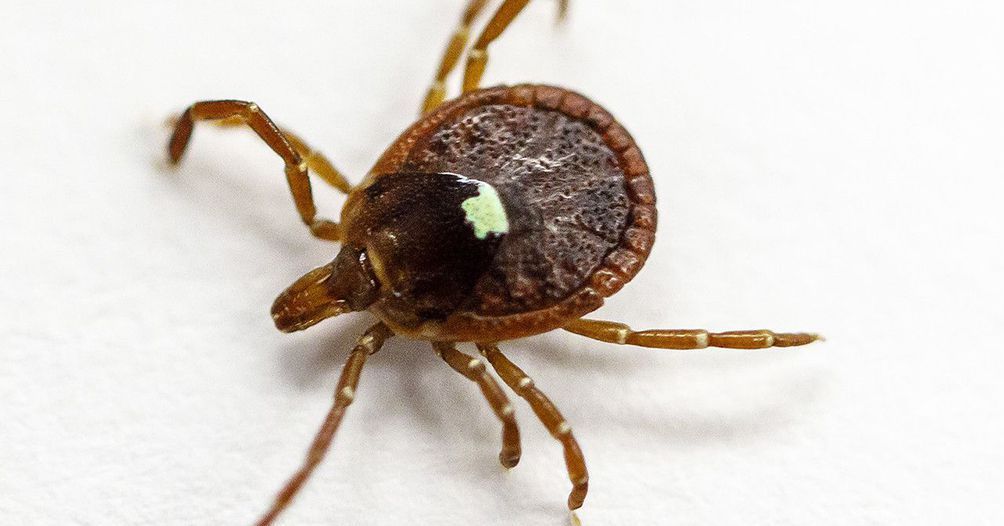This tick’s spit can make you allergic to meat
Very little can stop the average American from eating beef — and quite a lot of it. On a per-capita basis, Americans eat nearly 60 pounds of red meat a year, equivalent to more than one quarter-pound hamburger every other day. But there’s one obstacle to our meat-loving tendencies that may not be surmountable: the tiny but aggressive lone star tick.
The tick (named for the female’s distinctive white dot on its back) can spread something called sugar alpha-gal via its spit. That sugar can trigger alpha-gal syndrome, or AGS, a condition that causes hives, nausea, heartburn, diarrhea, difficulty breathing, and a drop in blood pressure, among other symptoms, in sufferers around two to six hours after they eat beef, pork, and other mammal products. Essentially, sufferers become severely allergic to red meat.
Since researchers first linked the syndrome to ticks in 2011, there have been more than 110,000 suspected cases. But new research released on Thursday by the Centers for Disease Control (CDC) estimates that the true number of sufferers between 2010 and 2022 may be as high as 450,000 people.
“I think those of us who live in it never thought the number was actually that low,” Dr. Jeffrey Wilson, an allergist and immunologist with the University of Virginia Health system, said of the confirmed number of cases. “I think the CDC report is one of the first, best attempts to get a good idea of what the real epidemiology of alpha-gal is.”
If accurate, the CDC’s AGS estimates would place an allergy to red meat as the 10th most common food allergy in the country, Dr. Scott Commins, a co-author of the CDC papers on AGS and a University of North Carolina researcher, told the Associated Press.
AGS does not always last for life, and is manageable by avoiding red meat, but if unaddressed it can be more than just a dietary nuisance — it can be deadly. “If a severe allergic reaction occurs, this can potentially be life-threatening,” Commins wrote Vox in an email. “We refer to that as anaphylaxis and numerous reports of anaphylaxis from AGS exist … Many patients carry an epinephrine auto-injector (epi-pen) for emergency situations.”
In the CDC’s press release, Ann Carpenter, an epidemiologist with the Epidemic Intelligence Service at the CDC and lead author of one of the papers released Thursday, said, “Alpha-gal syndrome is an important emerging public health problem, with potentially severe health impacts that can last a lifetime for some patients … It’s critical for clinicians to be aware of AGS so they can properly evaluate, diagnose, and manage their patients and also educate them on tick-bite prevention to protect patients from developing this allergic condition.”
Don’t panic just yet
Given the potential severity of AGS, the CDC’s reports raised clear alarm bells. One of the papers reported a spike in positive, lab-confirmed AGS cases, rising from 13,371 in 2017 to 18,885 in 2021. (The larger number of up to 450,000 cases in the CDC report is an estimate, based on a survey of health care professionals.) Additionally, while the lone star tick was previously found primarily in the South, the CDC report revealed that Suffolk County, New York, and Bedford County, Virginia, actually have the highest number of suspected AGS cases.
But scientists are still in the early stages of getting a fix on AGS. “Studying [AGS] is hard. I think for the most part, we’re just getting a better understanding of where the syndrome actually is,” Wilson said. “Is it slowly expanding or moving? It may be. In that study, Suffolk County, New York, lit up. But I think what that mostly tells us is that there are a lot of lone star ticks in Long Island. It’s not a brand new development, there’ve been a lot of lone star ticks on Long Island for some time.”
Some of the confusion may come down to just how unknown AGS is in the medical world — a second set of CDC findings showed that many health care workers remain uninformed about the syndrome. Forty-two percent of 1,500 surveyed general practitioners, internists, pediatricians, nurse practitioners, and physician assistants reported they did not know what AGS was. Thirty-five percent of the respondents reported they could not confidently diagnose or manage the syndrome.
But given the regionality of the illness, this shouldn’t be too concerning. “There’s a lot of parts of this country where you’re just not going to see [AGS], or it’s going be very rare,” said Wilson of the illness. “I think it’s almost not surprising that you’re going to have primary providers in many parts of the country who just aren’t going to know much about alpha-gal, or aren’t going to feel comfortable dealing with it.”
Another reason for the inability of health care providers to accurately diagnose the illness could be the delayed onset of the condition in relation to the food that causes the reaction, said Commins. Someone with AGS may not develop hives or gastrointestinal symptoms until hours after they’ve eaten red meat.
Additionally, not everyone who tests positive for the alpha-gal antibody will develop a red meat allergy, said Wilson. “It’s necessary, but not sufficient,” he said. The number of people who test positive for the blood marker is higher than the number who actually experience the symptoms of the syndrome.
Still, the higher number of estimated AGS cases aligns with a worrying increase in other tick-borne illnesses. As of 2018, ticks accounted for 77 percent of reported vector-borne diseases in the US, according to the CDC. Lyme disease accounted for 82 percent of the reported cases — between 1991 and 2018 Lyme disease cases per 100,000 people nearly doubled from 3.74 to 7.21 reported cases — and the report also showed a rise in spotted fever rickettsioses, babesiosis, and anaplasmosis cases.
Ironically, increased forest coverage because of reforestation efforts and a reduction in farming and a growing deer population (a major food source for many kinds of ticks) could be driving the trend. “Ticks that have made the biggest moves over the last few decades are those that rely heavily on deer as a reproductive host,” Thomas Mather, a professor and disease ecologist at the University of Rhode Island, previously told Vox’s Benji Jones.
What can we do about alpha-gal syndrome?
No treatment or cure for AGS exists. Therefore, the best way to protect oneself involves avoiding tick bites altogether. The CDC recommends doing so by wearing an EPA-registered insect repellant and long pants and socks while outdoors. Once inside, put your clothes in the dryer on high heat for 10 minutes, shower, and check yourself and your pets for the bugs.
And if you do discover a tick, removing it the proper way can save you from some types of tick-borne illnesses, including Lyme disease, which usually requires a tick to be attached to a person for between 36 to 48 hours to spread.
Use tweezers to hold the tick where it’s attached to your skin and steadily pull upwards. Afterward, clean the area. The CDC does not recommend using any other method for removal.
The more tick bites you get, the more likely you’ll experience prolonged AGS symptoms. So, even if you’ve already been bitten once, it’s not too late to start protecting yourself.
“Alpha-gal certainly in some of our patients can wane over time … for people who continue to get more tick bites it’s less likely to go away,” said Wilson. “For people who change their habits and do things to be more proactive about avoiding ticks, it’s more likely to go away over time.”
Source: Vox.com


